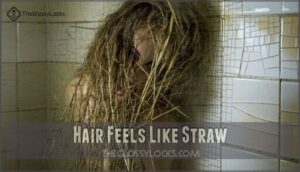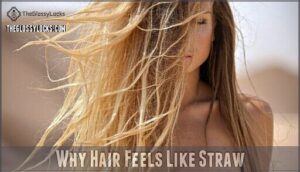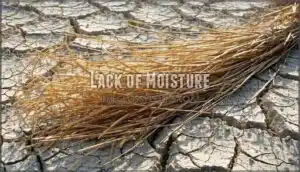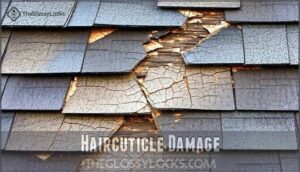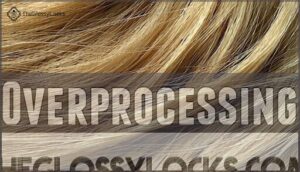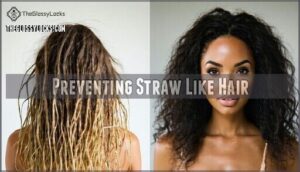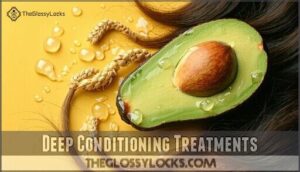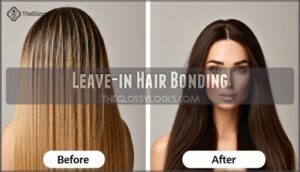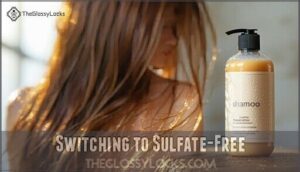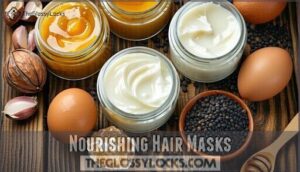This site is supported by our readers. We may earn a commission, at no cost to you, if you purchase through links.
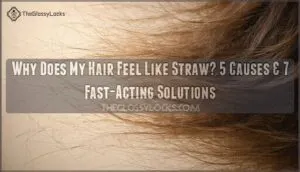 If your hair feels like straw, it’s probably crying out for moisture and repair.
If your hair feels like straw, it’s probably crying out for moisture and repair.
Things like overusing hot tools, frequent chemical treatments, or harsh shampoos can weaken your hair’s cuticle, leaving it dry and brittle.
Even sun exposure and cold weather can zap your hair’s hydration, making it rough and lifeless.
It might also hint at a lack of nutrients in your diet—your hair loves healthy fats and vitamins!
Think of your hair as a thirsty sponge; it needs the right care to bounce back.
Curious about quick fixes? There are simple ways to restore that softness and shine.
Table Of Contents
- Key Takeaways
- Hair Feels Like Straw
- Why Hair Feels Like Straw
- Causes of Dry Hair
- Preventing Straw Like Hair
- Restoring Hair Health
- Frequently Asked Questions (FAQs)
- How to fix hair that feels like straw?
- How do you hydrate your hair?
- How to fix dry brittle hair?
- Why does my hair feel like straw as I get older?
- Can hormonal changes affect hair texture?
- Does hard water impact hair condition?
- Are there genetic factors in hair dryness?
- Can stress lead to straw-like hair?
- Does hair porosity influence straw-like texture?
- Can stress or hormonal changes affect hair texture?
- Conclusion
Key Takeaways
- Understand that your hair feels like straw because it’s lost moisture and hydration and suffered cuticle damage from heat styling, harsh products, or chemical treatments.
- Deep condition weekly, switch to sulfate-free shampoos, and minimize heat styling to restore hydration and protect your strands.
- Keep your ends healthy with regular trims, and use nourishing products with oils or proteins to repair and strengthen damaged hair.
- Watch your diet and hydration levels—nutrients like biotin, iron, and healthy fats play a big role in maintaining soft, healthy hair.
Hair Feels Like Straw
When your hair feels like straw, you’re experiencing a significant loss of moisture and damage to the hair cuticle that prevents your strands from retaining essential hydration.
Straw-like hair signals lost moisture and cuticle damage—revive your strands with hydration-focused care for soft, healthy locks.
Your once-smooth locks have likely been compromised by chemical treatments, heat styling, environmental factors, or harsh hair care habits that strip away natural oils, leading to a significant loss of moisture and damage to the hair.
Chemical Processing Effects
Nearly every chemical treatment you undergo causes significant bond breakdown in your hair structure.
When you color, bleach, perm, or relax your hair, these processes strip moisture and weaken protein bonds that maintain your hair’s elasticity.
The result? Your once-silky strands transform into brittle hair that snaps easily.
Chemical processing basically disrupts your hair’s natural moisture balance, leaving it dry, damaged, and with that characteristic straw-like texture.
Chemical treatments wreak havoc on your hair’s moisture balance, turning silky strands into brittle, straw-like locks desperate for hydration.
Heat Styling Damage
Beyond chemical treatments, your hair styling routine might be turning your locks into straw.
That flat iron you love? It’s literally cooking your hair. Each pass of heat styling tools damages your hair’s protective outer layer, causing moisture loss that leads to brittle, strawlike hair.
Reducing styling frequency and lowering tool temperature can help, as can using heat protection products. Try embracing air drying and heatless styles to give your damaged hair a much-needed break.
Weekly treatments with deep conditioning masks can restore moisture.
Environmental Factors
While heat styling weakens your hair internally, don’t overlook what’s happening outside.
Environmental factors are silent hair destroyers. UV ray damage breaks down protein structures, while pollution effects coat your strands with microscopic particles.
Climate impact varies—dry air saps moisture, humidity causes frizz.
Water hardness leaves mineral deposits that make strawlike hair worse. Even seasonal changes require you to adjust your hair care routine to combat environmental damage to hair texture.
Harsh Haircare Habits
While you mightn’t realize it, your daily haircare routines could be turning your locks into straw.
Your habits might be doing more harm than good:
- Overwashing with harsh shampoos strips natural oils, leaving dry brittle hair
- Rough towel-drying creates friction that damages the cuticle
- Product overuse builds up residue that weighs hair down
- Tight hairstyles and improper brushing cause breakage and stress
Why Hair Feels Like Straw
Walking into a salon with straw-like hair often reveals underlying issues beyond simple dryness.
Your hair feels like straw because the structural integrity of your strands has been compromised. This rough texture occurs when your hair loses essential moisture and proteins that maintain its natural flexibility and shine.
| Hair Concern | Common Causes | Effect on Texture | Solution Focus |
|---|---|---|---|
| High Hair Porosity | Chemical processing | Rough, brittle strands | Protein treatments |
| Product Buildup | Silicone-heavy products | Coated, lifeless feel | Clarifying washes |
Unlike normal dry hair, straw-like hair indicates deeper damage. Internal hydration also plays a vital role—dehydration can manifest as brittle hair lacking moisture.
Addressing scalp buildup issues is also important for improving hair texture. Understanding these distinctions helps target your treatment approach more effectively.
Causes of Dry Hair
Your hair feels like straw because it’s missing essential moisture and natural oils, often stripped away by harsh products, heat styling, and environmental factors.
When your hair’s protective cuticle layer becomes damaged from chemical processing or frequent heat exposure, it can’t retain hydration properly, resulting in that frustrating brittle texture you’re trying to fix.
Lack of Moisture
The root of your straw-like hair often lies in insufficient hydration.
When your hair lacks moisture, it can’t maintain its natural elasticity and shine.
Your strands become brittle and rough to the touch as oil depletion occurs.
Different porosity levels affect product absorption – highly porous hair struggles to retain moisture while low porosity resists it.
Proper scalp health directly impacts how well moisture travels through your hair shaft, leaving damaged hair craving hydration.
The combination of these factors can lead to hair that is brittle, rough, and lacking in natural elasticity.
Haircuticle Damage
Beyond moisture loss, your straw-like hair might stem from damaged hair cuticles.
These protective scales that coat each strand can lift, crack, or erode completely.
When your hair cuticle becomes compromised, it increases porosity and damage, allowing harmful chemicals to penetrate while reducing moisture retention.
This protein loss explains why your hair feels rough and prone to breakage.
Think of cuticle layer erosion like roof shingles that have blown off during a storm—your hair is left exposed and vulnerable.
Overprocessing
While damaged hair cuticles contribute to rough texture, overprocessing is often the main culprit when your hair feels like straw.
Those frequent salon visits might be doing more harm than good. Chemical treatments stack damage upon damage, breaking down your hair’s natural structure.
- Bleach damage strips protein and moisture, leaving hair brittle
- Chemical overlap occurs when new treatments are applied before old ones heal
- Perm problems intensify when solutions stay on too long
- Relaxer effects compound with each application
- Color correction often requires multiple harsh processes
Chemical treatments, including perm problems and relaxer effects, can have lasting impacts on hair health, and understanding these factors is crucial for maintaining healthy hair.
Poor Diet
Looking at your hair in frustration, you mightn’t realize the culprit behind that straw-like texture is often sitting on your plate. Your hair’s health directly reflects what you eat, with nutrient deficiencies showing up as brittle, lifeless strands.
A holistic approach considers lifestyle and nutrition. Without these essential hair nutrients, your follicles can’t produce healthy strands.
| Nutrient | Function | Food Sources |
|---|---|---|
| Protein | Builds hair structure | Eggs, fish, beans |
| Biotin | Strengthens strands | Nuts, avocados, sweet potatoes |
| Iron | Delivers oxygen to follicles | Red meat, spinach, lentils |
You can learn more about preventing hair loss with a holistic approach, and understand how these nutrients play a crucial role in maintaining healthy strands and a balanced diet for overall well-being, including hair structure and lifestyle choices.
Preventing Straw Like Hair
You can save your hair from that dreaded straw-like texture by implementing protective measures that shield it from damage.
With consistent prevention strategies focused on gentle products, minimal heat, and regular maintenance, you’ll transform your brittle strands into the smooth, healthy hair you’ve been missing.
Minimizing Heat Styling
Now that you understand why your hair feels dry, let’s tackle one of the biggest culprits: heat styling. Your flat iron and blow dryer are basically cooking your strands.
Try embracing heatless styling methods like braids or twists overnight. When you must use styling tools, lower those tool temperatures and never skip heat protectants.
Using quality heat protection can substantially reduce damage. Air drying whenever possible gives your hair a much-needed break from heat damage and breakage.
Using Gentle Products
While reducing heat is helpful, your product selection matters just as much.
Switch to sulfate-free shampoos and products with natural ingredients that won’t strip your hair’s moisture. Hydrating formulas with ingredients like argan oil or shea butter provide gentle cleansing while supporting hair hydration and repair.
Many consumers are now buying sulfate-free hair products.
Think of your damaged hair like a delicate plant—it needs the right nutrients, not harsh chemicals that’ll leave it feeling like straw, and consider using products with natural ingredients for gentle cleansing.
Regular Trims
Now that you’re using gentle products, don’t forget the power of regular trims.
Getting your hair trimmed every 6-8 weeks prevents split ends from traveling up the shaft and causing more breakage.
These maintenance cuts don’t hamper growth but actually promote it by keeping your hair healthy from end to end.
Even a mini-trim (1/4 inch) helps maintain shape while preventing dry, damaged hair from developing that familiar straw-like texture.
Protective Styling
Protective hairstyles are your hair’s best friends when it tackles straw-like texture.
Braids and buns minimize exposure to damaging elements, while silk scarves provide night protection against friction.
Low manipulation styles reduce breakage and preserve moisture, and when you do handle your hair, practice gentle detangling with wide-tooth combs.
These techniques create a shield against hair dryness and split ends, giving damaged strands time to recover, and overall help to minimize breakage.
Restoring Hair Health
You’ll be relieved to know that even the most straw-like hair can be restored with consistent care and the right treatments.
Your journey back to soft, manageable hair starts with addressing moisture loss and repairing damaged cuticles through targeted solutions, which is a crucial step in restoring hair health and achieving soft hair.
Deep Conditioning Treatments
Now that you’ve set up preventive measures, it’s time to repair existing damage with deep conditioning treatments. These intensive hair repair solutions work wonders on straw-like strands.
For maximum hair moisture benefits:
- Apply treatment to damp hair, focusing on ends
- Cover with a shower cap for heat retention
- Leave on for 20-30 minutes (or overnight for severe damage)
- Rinse with cool water to seal cuticles
DIY recipes using ingredients like avocado can be just as effective as salon products when used weekly. These treatments hydrate and strengthen damaged hair to provide maximum hair moisture and help hydrate the hair.
Leave-in Hair Bonding
Revitalize your straw-like strands with leave-in bonding treatments that repair up to 85% of damage.
These powerful formulations contain amino acids, proteins, and plant extracts that rebuild broken bonds in your hair shaft.
Apply after washing for protection against heat up to 450°F. For best results, use weekly and customize with concentrates for your specific concerns.
Regular application prevents re-damaging while locking in moisture for smoother, healthier hair with leave-in treatments.
Switching to Sulfate-Free
If your hair feels like straw, switching to sulfate-free products can help.
Sulfates strip natural oils, leaving hair dry and brittle. Instead, choose gentle cleansing options for better hydration and scalp health.
Look for moisturising shampoos with sulfate alternatives like coconut-based cleansers. You’ll notice softer strands and fewer hair dryness causes over time.
Who doesn’t love smoother locks? Switching to sulfate-free products and using gentle cleansing options can make a significant difference in the health and feel of your hair.
Nourishing Hair Masks
If your hair feels like straw and lacks moisture, nourishing hair masks can work wonders.
From DIY masks with egg whites and honey to salon favorites, these restore hydration and repair damage.
Use weekly for the best results.
To explore various options, consider different mask products.
Black Seed Oil
Wheat Protein
Frequently Asked Questions (FAQs)
How to fix hair that feels like straw?
Think of your hair like a thirsty plant—it needs water and care.
Use sulfate-free shampoos, deep condition weekly, avoid heat styling, and moisturize with leave-in treatments or oils.
Trim regularly to banish damaged ends.
How do you hydrate your hair?
To hydrate your hair, use a deep-conditioning mask weekly, switch to sulfate-free shampoo.
Apply leave-in conditioner or nourishing oils like argan.
Limit heat styling, and air-dry whenever possible for healthier, softer strands.
How to fix dry brittle hair?
Treat your hair like a thirsty plant—trim dead ends, minimize heat styling, and switch to sulfate-free products.
Deep condition weekly, use nourishing oils, protect against sun damage, and consider a water softener to reduce dryness, which helps to keep your hair healthy and strong with sulfate-free products.
Why does my hair feel like straw as I get older?
As you age, your scalp produces less natural oil, leaving hair drier and more prone to damage.
Combined with environmental factors, hormonal shifts, and styling habits, this can make your strands feel straw-like.
Can hormonal changes affect hair texture?
Like shifting seasons, hormonal changes can reshape your hair’s texture.
Pregnancy, menopause, or thyroid issues might leave it drier, thinner, or curlier.
Those internal shifts alter oil production and elasticity, impacting your hair’s feel dramatically.
Does hard water impact hair condition?
Hard water can damage your hair by leaving mineral deposits that strip its natural moisture, making it dry, brittle, and prone to breakage.
It’s like your hair’s wearing a chalky, dehydrating coat.
Are there genetic factors in hair dryness?
Imagine your hair as a family heirloom—genes can shape its moisture levels.
If your parents had dry hair, you might inherit it, as natural oil production, hair structure, and porosity often follow genetic patterns.
Can stress lead to straw-like hair?
Stress can absolutely make your hair feel like straw.
It disrupts hormone levels, reducing scalp oil production and weakening strands.
Combine that with poor sleep or diet, and your hair’s moisture takes a serious hit.
Does hair porosity influence straw-like texture?
Your hair’s porosity—its ability to absorb and retain moisture—plays a big role.
High porosity lets moisture escape quickly, leaving strands dry.
Low porosity resists hydration, creating buildup, which can lead to that straw-like texture.
Can stress or hormonal changes affect hair texture?
Changes in hormones or stress can disrupt your scalp’s oil production, leaving your hair dry and brittle.
It’s like your hair is throwing a tantrum—chaotic, unpredictable, and craving balance through self-care and patience.
Conclusion
Sure, your hair feeling like straw mightn’t be the compliment you were hoping for, but it’s fixable.
By addressing common culprits like heat damage, overprocessing, or harsh products, you can restore your hair’s hydration and softness.
Swap out bad habits for nourishing ones—think deep conditioners, sulfate-free shampoos, and a healthier diet. Your hair’s crying out for care, not criticism.
With a consistent routine, you’ll soon forget to ask, "Why does my hair feel like straw?
- https://gkhair.co.uk/blogs/all-blog-posts/why-does-your-hair-feel-dry-brittle-straw-like
- https://www.realsimple.com/hair-feels-like-straw-7565518
- https://www.equibotanics.com/blogs/news/why-does-my-hair-look-like-straw-and-is-falling-out?srsltid=AfmBOor8yrV3qqU_dZUtlsDyOZbUN-3fQpSFByGgVO4uvmHFTFD5RRDd
- https://www.johnfrieda.com/en-uk/blog/hair-care/why-is-my-hair-so-dry/
- https://itsa10haircare.com/blogs/blog/hair-feels-like-straw-restore-dry-hair?srsltid=AfmBOop-c0sijVtEy5zLfAzFUvs7Cl_N3CWt8YDYEzQoogVtgTYahaYD

